
Check out our article about transforming last mile delivery through technology. You will discover more about logistics challenges and its consequences and get necessary knowledge on essential features of last mile transportation solutions that can solve them. Get a free consultation of our experts.
Reading time: 17 min.
The last mile. It’s the final stretch of a package’s journey—a move from a transportation hub to its destination, often home or a retail store.
To grasp the core, look at this simple breakdown of the last mile process.
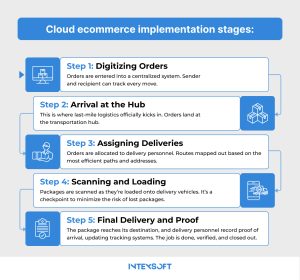
Now, let’s assess the predictions.
We can confidently rely on the stats that anticipate the skyrocketed future of last-time delivery. The value of this market will rise and achieve USD 84.72 billion in the next 5 years. Store owners understand that online shopping has to be more attractive, convenient, customer-friendly, and less stressful for clients, so that is why we can be confident in our market predictions.
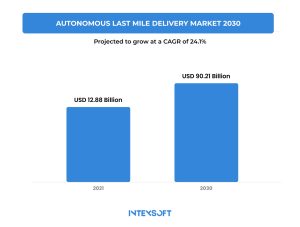
84% of consumers would not shop with a retailer after having a bad delivery experience. This statistic underscores the need for last mile improvements that are requirements. Ecommerce businesses and delivery companies see it as a critical battleground for customer loyalty in the years ahead.
This is where technology steps in. Advanced last mile logistics software is emerging as the solution, tackling the core issues that plague the process—delays, inefficiencies, and the high cost of fuel.
Let’s dig into the specifics.
This type of logistics doesn’t just close the loop—it swallows up 53% of shipping costs, demanding close attention from businesses everywhere.
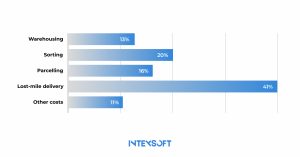
This phase has hurdles that can trip up even the most seasoned operations. So, let’s break it down, challenge by challenge, to understand precisely what businesses are up against.
In the following part, we will highlight last mile problems and ways to solve them with IT technologies.
The fact is that today, customer expectations have become uncompromising.
On the front page are efficiency, convenience, friendly and knowledgeable service, and easy payment.
Assess what customers value in the logistics of their shopping journey from the stats below:
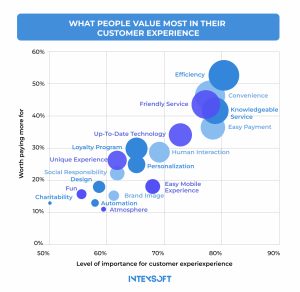
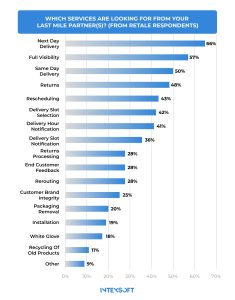
Now about speed, which is a demand. Studies reveal that 70% of consumers rank this factor as the most important among others. 90% expect delivery within two to three days, while nearly a third demand same-day service.
Even a minor delay feels like a breach of trust. Companies face a harsh new reality: anything short of near-instant gratification risks a sale and loyalty in the long run.
Customer expectations extend beyond speed. Precision in customizing every interaction is also very important. Shoppers expect to be satisfied before they even realize their needs.
These old-age challenges are clear: high costs and the complexity of sustainability.
Fuel consumption often consumes more than half of the total shipping costs.
Yet, there are solutions, and the most successful players are already ahead of the curve.
FedEx, for example, has embraced a route optimization system, deploying algorithms that cut unnecessary miles and drive down fuel use. UPS famously uses its “no left turn” approach—avoiding left turns and idling—to save millions of gallons in fuel every year.
And Amazon? They’ve invested heavily in software to control electric vehicles and even bike-based deliveries in urban centers, reducing emissions and operational costs in one stroke.
These examples point to a future where logistical efficiency and environmental responsibility don’t just coexist—they reinforce each other.
This is the third challenge that can be avoided with the right IT technologies.
Last mile delivery software provides tools to optimize every aspect, including route planning and real-time tracking. These solutions leverage data to predict the most efficient paths. For example, you can identify optimal delivery sequences and reroutes drivers in real time to avoid traffic.
Customers now expect live updates. Companies can send real-time notifications to customers and allow them to track their deliveries minute by minute. This transparency significantly reduces failed delivery attempts.
Last mile delivery solutions allow customers to choose their preferred delivery windows; companies can prevent missed deliveries and save on reattempt costs.
Navigating this challenge isn’t easy without the right technologies. Advanced software, however, brings real power to the table. These tools make it possible to benchmark against competitors, assess performance, and fine-tune operations in ways that weren’t possible before.
Last mile delivery system collects and analyzes massive amounts of data, from delivery times to customer satisfaction metrics. The result? Actionable insights that spotlight exactly where businesses can improve.
Take real-time analytics, for example. These tools reveal delivery speed comparisons and flag areas where competitors might get packages to clients faster or at a lower cost. Armed with this information, you can recalibrate their strategies to stay wise and competitive.
Beyond individual metrics, last mile delivery logistics solutions provide a bird’s-eye view of industry-wide trends and track the rise in electric vehicle use or the growing consumer demand for flexible delivery options. This software can also forecast peak-season demand. Some solutions even parse customer feedback across the sector to offer insights into what really matters to clients—and where competitors might be slipping.
Consider this as a green baseline. Customers expect environmentally conscious choices, and regulations around emissions are tightening globally. Yet, achieving true sustainability in delivery is no small feat, notorious for its resource intensity.
This last mile issue is closely connected with fuel expenses.
Implement last mile logistics software to gain a robust toolkit. Route optimization in real-time reduces unnecessary fuel consumption and minimizes idle time.
Labor costs can impact a company’s budget, especially during peak seasons when demand skyrockets. However, advanced logistics software has the capacity to streamline labor deployment through predictive analytics that enables businesses to allocate resources exactly where and when they’re needed.
Consider Amazon, which utilizes such logistics software to optimize the dispatch of delivery personnel. By sending workers on shorter, more efficient routes, the company enhances productivity while minimizing overtime expenses.
Dynamic scheduling has gained traction as a crucial feature, allowing companies to reassign drivers in real time to address unexpected delays or fluctuations in order volume. This proactive approach helps manage labor costs successfully.
The pitfalls of exponential cost increases pose a significant challenge in last-mile delivery, a common issue for businesses scaling their operations rapidly.
Think of cloud-based last mile logistics platforms as a flexible elastic band—stretching to accommodate peak seasons without snapping under pressure. This software offers the agility needed to maintain a robust infrastructure.
With modular software solutions, businesses can quickly adapt to various geographic regions and delivery types.
For example, during the recent ecommerce surge, companies that utilized last-mile logistics software could pivot quickly, bringing on additional drivers or tapping into third-party fleets without missing a beat. This means businesses can ride it smoothly rather than being overwhelmed when demand surges like a sudden wave.
| Feature | Description |
| Dynamic Routing | Smart routes adjust in real-time, cutting delays, saving fuel, and adapting to changes as they happen. |
| Maximizing Fleet Efficiency | Maximizes fleet capacity and reduces idle time, getting more done with fewer resources. |
| Customer Status Updates | Keeps customers informed minute-by-minute, reinforcing trust with transparent tracking. |
| Failed Deliveries Workflow | Efficient reattempt and redelivery plans ensure no order slips through the cracks. |
| Variety of Proof of Delivery | Options from digital signatures to photos provide flexibility and secure confirmation. |
| Performance Analytics | Tracks key metrics, offering insights to drive improvements and boost delivery speed, accuracy, and satisfaction. |
| Easy Supply Chain Integration | Seamlessly connects with larger systems, creating a smooth data flow across all stages of fulfillment. |
When it comes to the features that provide truly valuable benefits, consider the seven from the table above. Now, it’s time to pay attention to each of them individually.
Roads close, traffic jams pile up, and weather conditions shift, creating a real-time maze. But with dynamic routing, companies find a path that’s nimble, recalculating routes as conditions change. Think of UPS’s “no left turn” policy mentioned above; it’s saved the company millions.
IntexSoft knows how to achieve this success through intelligent routing algorithms. Our last mile solutions always offer companies true flexibility in this field.
This feature allows business owners to precisely control the fleet, like pieces on a chessboard, each move, mile, and minute calculated.
You can analyze routes, optimize driver assignments, and group deliveries in dense areas. The result is reduced costs and a leaner operation that keeps things running.
In the customer’s eyes, delivery isn’t complete until the package is in hand, and knowing when it’s coming is as essential as the delivery itself.
Last mile software ensures this by providing real-time updates and sending notifications at every step. Imagine this as tracking a plane’s journey: you know when it takes off, where it’s landing, and if there’s a delay.
Customers expect this excellent visibility, and companies that deliver on it build trust. It’s about keeping the lines open, meeting expectations, and transforming the delivery experience from uncertain waiting to well-informed, confident fulfillment.
Failed deliveries may happen. But with the right software, the business has a robust workflow that creates a clear, systematic response for every undelivered package, sparing the costly repercussions of repeat attempts.
The failed deliveries are routed through automated workflows that notify drivers and customers instantly. Each failed attempt triggers a recovery sequence, including rescheduling options or directing the package to secure drop points. This structured system guarantees that drivers aren’t retracing steps unnecessarily and that customers aren’t left in the dark.
This workflow is a safeguard and a reset button. It keeps the wheels moving forward, preventing one mistake from becoming a day-long setback.
In the delivery world, time is money, and every minute salvaged from a failed attempt can be reinvested elsewhere. So, this feature is important.
POD is the “receipt” at the end of a transaction, but it’s far more crucial.
It serves as a mark that every delivery attempt has a recorded outcome, leaving a trail that keeps the chain of custody transparent from start to finish. And today, that assurance is priceless.
This feature of last mile transportation solutions is critical evidence that the package reached its intended destination.
POD methods can vary. For example, they may include geo-stamped photos showing packages at the doorstep, allowing for quick, location-based verification without disturbing the customer. Alternatively, electronic signatures can be used for more security-sensitive items.
This variety of POD methods ensures there’s an option suited for every delivery scenario.
This feature offers an unfiltered look into every mile traveled, every minute spent, and every stop made to help you understand where efficiency meets obstacles. For logistics, it means analyzing delivery times, driver routes, and customer satisfaction metrics—insights for fine-tuning operations.
Performance analytics in last mile delivery technology turns a static map into a responsive, living system where problems are predicted rather than reacted to. It shows companies where to steer next.
A powerful last mile solution can’t function as an island.
Integration with the wider supply chain—the warehousing, packaging, and inventory systems—is necessary. It holds the entire logistical body together, ensuring a seamless flow of information and operations from start to finish.
Let’s look at Walmart as a last mile delivery example. Its ability to deliver at scale relies heavily on its integration across systems. Orders move from inventory to dispatch in real time, ensuring no step is missed. If an item runs low in stock, the wider supply chain responds immediately, informing every piece of the system. This integration allows drivers to head to the correct warehouse at the right time, minimizing wasted trips and maximizing efficiency.
So, you’ve walked through the last mile challenges, and the features of software solutions offer to ease them. But now, it’s time to get down to the details. Is investing in last-mile tech indeed the right move for your business? Can it really tackle all your pain points? And what about cost, timing, and potential pitfalls?
These are serious questions, and they deserve precise answers. At IntexSoft, we’re ready to offer advice that speaks to your unique situation. Our team is prepared to look at the specifics of your operation and help you see which last-mile solutions are the right fit. Remember, our expert consultation is free.